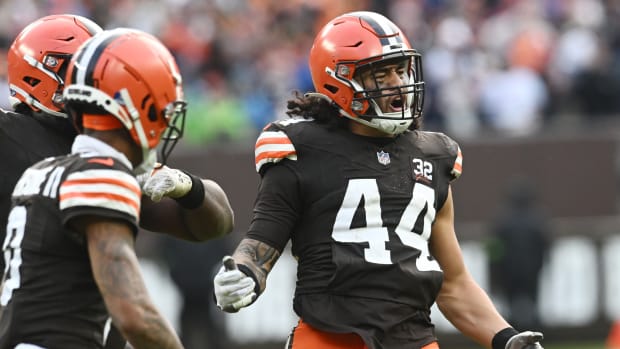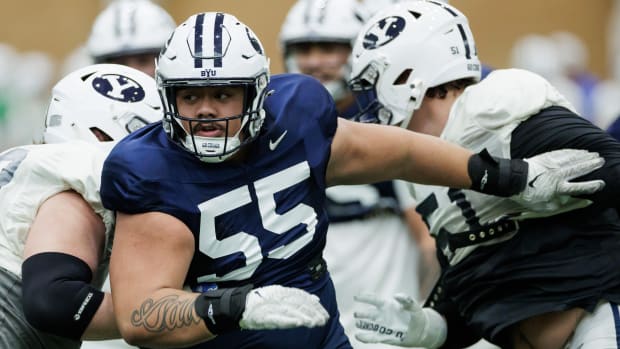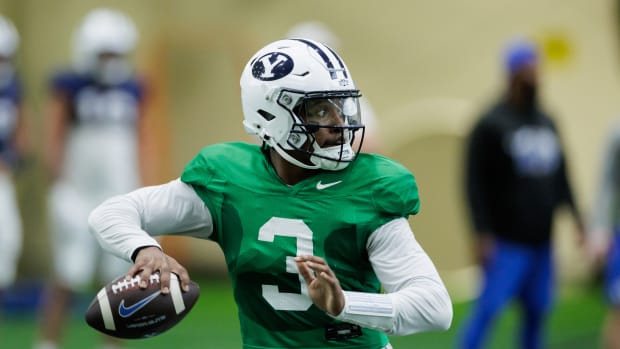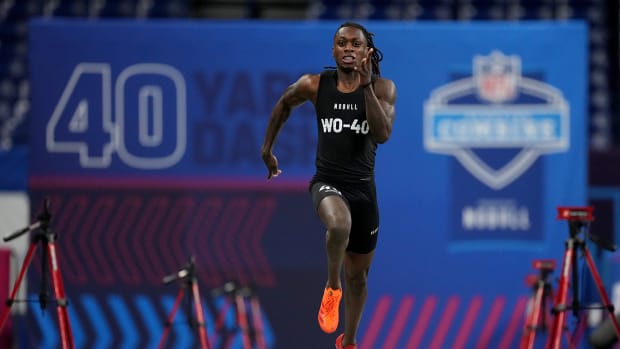Unpacking the Concerning Trends of BYU’s Defense
By the metrics, BYU's defense was better than BYU's offense at the beginning of Kalani Sitake's tenure. The 2016 team featured future NFL defenders like Fred Warner, Sione Takitaki, Harvey Langi, Michael Davis, Dayan Lake, Troy Warner, and Corbin Kaufusi. BYU's defense continued to be better than the offense until 2019 when the two units converged. In 2020, the offense surpassed the defense when Zach Wilson took BYU's offense to new heights. Ever since 2020, BYU's offense has been the better unit, at least by the metrics.
Last Saturday, BYU was completely reliant on its offense to keep up with the Razorbacks. After getting two stops to start the game, BYU's defense allowed scores on eight straight possessions, seven of which were touchdowns. BYU's offense ran out of gas and a late fumble sealed the Cougars' fate.
Over the last few days, BYU's defense has been under a lot of scrutiny. Kalani Sitake has hinted at role changes to the press, but he hasn't announced any official changes to defensive responsibilities.
This week, we looked back at the data to understand the state of the BYU defense today. We relied on the numbers to tell us which criticism of the defense is fair and which is not. Today, we break down the trends of the defense under Kalani Sitake and defensive coordinator Ilaisa Tuiaki.
The Relationship Between Experience and Performance
From 2016 to 2020, BYU's average SP+ ranking on defense was 40. The ranking seesawed back and forth every season, however, depending on the returning experience of that group. BYU's defense ranked in the top 35 in both 2016 and 2018 when they ranked in the top 35 in returning production. Performance dropped off slightly in 2017 and 2019 when the Cougars returned less experience.
| Year | SP+ Ranking - Defense | Returning Production Ranking - Defense |
|---|---|---|
2016 | 33 | 33 |
2017 | 56 | 47 |
2018 | 33 | 28 |
2019 | 57 | 85 |
2020 | 21 | 72 |
2021 | 79 | 127 |
2022 | 82 | 1 |
2020 was an anomaly (that will be a trend to remember). The Cougars ranked 72nd in returning production and 21st in the SP+ defensive rankings. Due to COVID-19, of course, the 2020 schedule was completely different from the other schedules and BYU didn't play against a Power Five team. Those factors make 2020 a difficult season to draw many conclusions from. After all, it's reasonable to suggest that BYU's strength of schedule boosted their efficiency metrics on defense.
So let's ignore 2020 for now and look at 2021. According to these trends from the Sitake era, BYU's defense was expected to take a big step back: the Cougars returned less experience on defense than any team in the country. BYU's defense finished the 2021 season ranked 79th in SP+, the worst ranking of the Sitake era. Ideally, you would have liked to see BYU hold on to a spot in the 50's like it did in 2017 and 2019. But again, it was explainable since returning so little production was unprecedented.
Coming into the 2022 season, BYU's returning production was well documented, especially on defense. The Cougars ranked first in returning defensive production by a wide margin. So if the trends of the past held true, the BYU defense was expected to make notable improvements in 2022.
Unfortunately, that hasn't been the case through the first seven games. BYU's defense ranks 82nd in SP+ after allowing 52 points against Arkansas. So why hasn't BYU bounced back like everyone expected? Here are three core reasons that, when combined, could be causing the issue.
Recruiting on Defense
BYU's defensive staff has deployed a different recruiting strategy from the offensive staff. The defensive staff has really valued measurables and projecting the ceiling players, even if they are not being recruited by other schools. BYU's offense, on the other hand, has deployed a more traditional approach: going head-to-head in recruiting battles to land their top targets. As a result, the offensive staff has signed more highly-touted players with competing P5 and FBS offers. The defense has had its share of recruiting wins as well, but they have been less frequent than the offense.
Those recruiting trends have manifested themselves on the field this season. BYU's defense has played 523 snaps this season. With 11 players on that field, there have been 5,753 (11 x 523 = 5,753) defensive reps played in 2022. Just 35% of those reps have come from players that held at least one competing P5 offer out of high school. 51% of the reps were played by guys that held a competing FBS offer coming out of high school.
How does that compare that the offense? 56% of offensive reps have come from guys who held P5 offers out of high school and 78% from players who held FBS offers.
Offer sheets aren't the perfect measure of recruiting success, but they are a measure. And according to competing offers, BYU's offense is fielding more guys that were highly-touted recruits.
It's unfair to say that defensive recruiting has been bad across the board. BYU has found some really great players over the last seven years, and there are multiple recent signees that were highly-touted recruits. Think of guys like Logan Fano, Raider Damuni, Aisea Moa, John Henry-Daley, Tate Romney, and Bodie Schoonover to name a few. Those guys will be fixtures on the defense in the future, but they aren't on the roster yet. The roster is made up mostly of players that signed from 2016-2019. That's the reality of recruiting at BYU.
Most importantly, the data points out an issue: BYU hasn't adapted its recruiting well enough for its own scheme. That conclusion was drawn by looking at the mix of Mendenhall-era recruits and Sitake-era recruits since 2016. BYU’s defensive production has dropped off as more Mendenhall-era recruits leave the program. Again, 2020 is the exception to the rule. 2021 and 2022 were the first seasons where Mendenhall-era recruits played less than a third of the total defensive reps.
So whether it is the scheme, the personnel, or the combination of the two, it's a concerning trend that needs to be addressed. It's even fair to say that it is being addressed - BYU's recruiting has improved since accepting an invitation to join the Big 12. Some of BYU's most talented players are now in the pipeline. It was primarily recruiting from 2017 through 2020 that put BYU in the position it's in today.
The Scheme
Fairly critiquing a scheme is incredibly challenging to do. There are many things we don’t know about the scheme, like specific responsibilities and how the scheme is taught. So instead of getting lost in speculation, let’s talk about what we know about BYU’s defensive scheme.
First, BYU has won a lot of games with this defensive scheme. Hate it, love it, it doesn’t matter. BYU has won a lot of games with this scheme. That's important to remember.
Second, BYU has struggled to pressure the quarterback in this scheme. BYU currently ranks 117th in the country with 1.29 sacks per game. Many fans point to rushing three and dropping eight as the reason for BYU's struggles to pressure the quarterback. That has certainly been the culprit at times, but not always. BYU brought multiple blitzes against Notre Dame and Arkansas that didn’t pressure the quarterback. What’s worse than dropping eight and giving the quarterback a long time to throw? Dropping six into coverage and giving the quarterback a long time to throw. When Sitake and Tuiaki were at Utah, they turned Salt Lake City into Sack Lake City. BYU fans hoped for a similar outcome in Provo (minus the nickname, perhaps). What most fans don’t always remember about the Utah defenses of old, is Utah’s pass rush usually consisted of four rushers. Utah’s defense was so suffocating because it only needed four rushers to pressure the quarterback. Then when they blitzed, the quarterback had to get the ball out of his hands immediately. Dropping players into coverage is a great scheme if you can pressure the quarterback. If you don't pressure the quarterback, receivers are going to get open even if they are outnumbered two to one. Rushing three, four, or five hasn't mattered, BYU’s defense has struggled to pressure the quarterback.
Third, this scheme lacks identity at times. BYU adopts its scheme each week to its opponent. Players have said as much in press conferences. Or perhaps the identity of this scheme is to be malleable. Regardless, that’s likely the reason why BYU’s philosophies can vary so much week by week. In the opinion of this author, a lack of identity has hurt the defense. Let’s take 2019 as an example when BYU’s defense was still slightly better that the offense. In 2019, BYU allowed Hawaii quarterback Coke McDonald to throw for 493 yards in the Hawaii Bowl. That same season, the BYU defense allowed 243 rushing yards in a loss against USF when the Bulls struggled to throw the football. Altering schemes to opponents hasn’t allowed BYU hang its hat on one thing it does really well.
Dropping a lot of players into coverage should prevent big plays and force offenses to patiently move the ball down the field. That was the case from 2016 - 2018 when BYU ranked in the top 50 of college football in allowing plays of 10 or more yards. Since 2019, BYU has allowed more big plays. This season, BYU ranks 82nd in the country in plays allowed of 10 or more yards with 95. If aggression isn't your calling card, then you must prevent big plays. That's been a struggle in 2022.
The Infamous Hockey Subs
If you've watched games around college football, BYU's substitution strategy is unlike most teams in the country. That doesn't inherently make it bad, but it is certainly unique. BYU routinely rotates large groups of substitutions during drives that last more than a few plays. The idea is to keep the defenders fresh. It makes sense on paper if your backups are better than the starters at 70%-80% strength. In practice, it puts BYU's second and third-string players on the field in critical moments and it causes alignment issues. Check out this play from last Saturday as an example, BYU brings in 11 new players for a critical third down. The players rotating in the game are looking for the call from the sidelines. Meanwhile, Arkansas has three wide receivers lined up on the short side of the field. BYU only has time to put one cornerback on the side of three wide receivers, and the Razorbacks get an easy first down conversion on a screen pass.
25 players have played 90% of the snaps on defense. On offense, only 15 players have played 90% of the snaps. BYU's defensive depth has been tested because of this substitution strategy. Few teams in college football have enough depth to consistenly play 25 guys on defense. Given the recruiting results we reviewed earlier, it's difficult to believe that BYU's third-string players are ready to make critical plays in critical moments.
Up-tempo offenses like Arkansas can exploit this strategy. Once the Razorbacks found a matchup they liked, they could go into an up-tempo offense to take advantage of that matchup. That happened on various occasions last week.
The Impact on the Offense
Perhaps the most difficult to quantify is the defenses impact on the offense. BYU's defense has given up a lot of yards. Through seven weeks, the Cougars rank 87th in available yards allowed. Allowing yards is directly correlated with the average starting field position of your offense. Therefore, it's not a surprise that BYU ranks 100 out of 131 FBS teams in average starting field position.
Most interesting, is that BYU's defense has been put in advantageous positions this season. The average starting field position of BYU's opponents this season is their own 26 yard line. That is the 10th best in the country. Starting field position is the leading indicator for points per drive in college football. Essentially, BYU's defense has consistently allowed its opponents to flip the field and put BYU's offense at a disadvantage.
Last season, BYU's offense was so efficient that it made up for the yards allowed by the defense. BYU's offense was a top five offense in efficiency last season according to FEI ratings. This season, BYU's offense is ranked 20th by the same ratings. BYU's defense ranks 88th in efficiency, meaning it relies on BYU's highly-efficient offense to stay in games. That is on average of course. There have been other games like the win at Baylor where an outstanding defensive effort kept BYU in the game.
Back Half of the Season
It's not too late for BYU to turn this season around and show improvement on defense. BYU's defense has put together some solid performances against Baylor and Notre Dame, showing that it has the talent to win games when it plays well. It needs to be more consistent and show an ability to get off the field on third downs. Don't be surprised if the defense looks different against Liberty this weekend. Like we said at the beginning, Coach Sitake has hinted at changes throughout the week.





